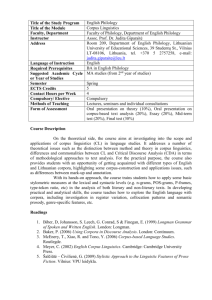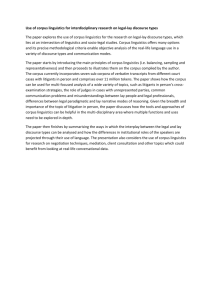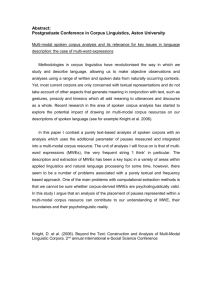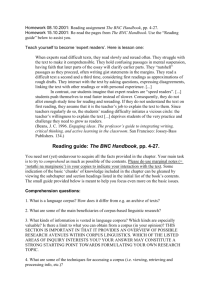English 806: Seminar in Linguistics: Corpus Linguistics
advertisement
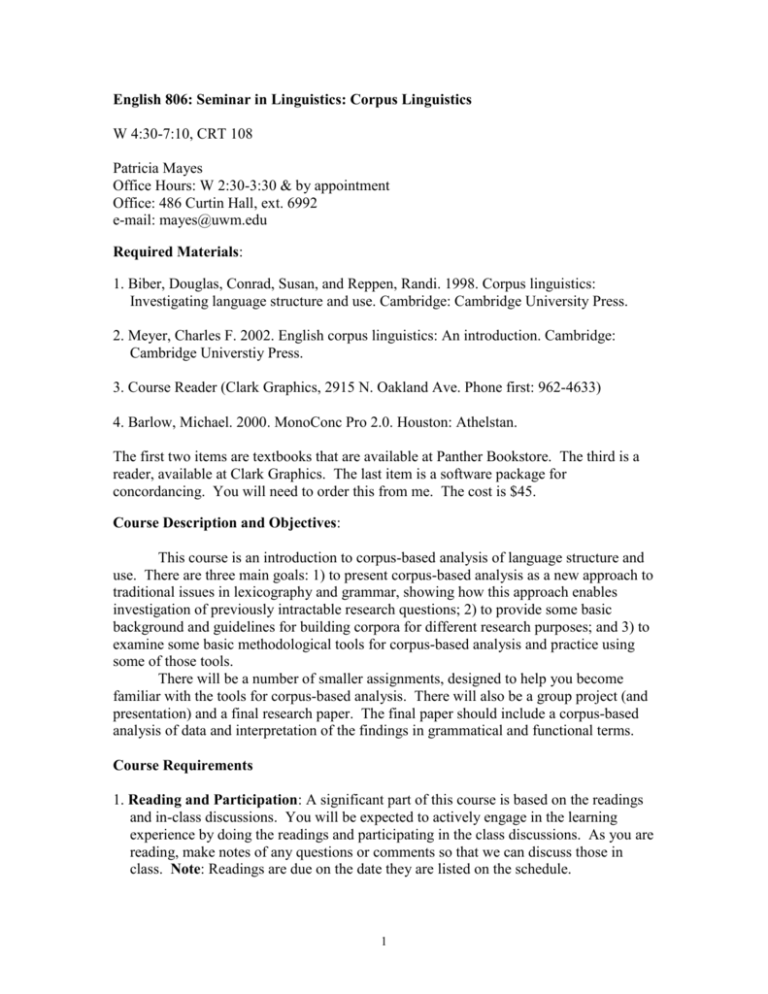
English 806: Seminar in Linguistics: Corpus Linguistics W 4:30-7:10, CRT 108 Patricia Mayes Office Hours: W 2:30-3:30 & by appointment Office: 486 Curtin Hall, ext. 6992 e-mail: mayes@uwm.edu Required Materials: 1. Biber, Douglas, Conrad, Susan, and Reppen, Randi. 1998. Corpus linguistics: Investigating language structure and use. Cambridge: Cambridge University Press. 2. Meyer, Charles F. 2002. English corpus linguistics: An introduction. Cambridge: Cambridge Universtiy Press. 3. Course Reader (Clark Graphics, 2915 N. Oakland Ave. Phone first: 962-4633) 4. Barlow, Michael. 2000. MonoConc Pro 2.0. Houston: Athelstan. The first two items are textbooks that are available at Panther Bookstore. The third is a reader, available at Clark Graphics. The last item is a software package for concordancing. You will need to order this from me. The cost is $45. Course Description and Objectives: This course is an introduction to corpus-based analysis of language structure and use. There are three main goals: 1) to present corpus-based analysis as a new approach to traditional issues in lexicography and grammar, showing how this approach enables investigation of previously intractable research questions; 2) to provide some basic background and guidelines for building corpora for different research purposes; and 3) to examine some basic methodological tools for corpus-based analysis and practice using some of those tools. There will be a number of smaller assignments, designed to help you become familiar with the tools for corpus-based analysis. There will also be a group project (and presentation) and a final research paper. The final paper should include a corpus-based analysis of data and interpretation of the findings in grammatical and functional terms. Course Requirements 1. Reading and Participation: A significant part of this course is based on the readings and in-class discussions. You will be expected to actively engage in the learning experience by doing the readings and participating in the class discussions. As you are reading, make notes of any questions or comments so that we can discuss those in class. Note: Readings are due on the date they are listed on the schedule. 1 2. Short Assignments: These will be given in class the week before they are due. 3. Group Project: Using your own data or some of the data made available in class, you will use one of the corpus-based methods we have covered to analyze the data. You are encouraged to work in groups. Findings will be presented in class as well as handed in. 4. Final Paper: This is based on a term project. Requirements for the paper are as follows: length – about 15 double-spaced pages data – use corpus data (class data, a corpus you purchased or otherwise downloaded, or a corpus you constructed) method – corpus-based methods (discussed in class or researched outside of class) analysis – include a functional interpretation of the findings Grading Class Participation Short Assignments Group Project Final Paper 10% 35% 20% 35% Tentative Schedule BCR = Biber, Conrad, and Reppen Week/date 1 (1/22) 2 (1/29) Topic Course Introduction Issues in Corpus Design Readings BCR Ch 1; Meyer Ch 1 Meyer Ch 2, Appendix 1; BCR Ch 6, Meth Box 1-2 3 (2/5) Corpus Design (continued)/MICASE Meyer Ch 3; Davies; Powell & Simpson 4 (2/12) Lexicography and Concordancing 5 (2/19) Concordancing (MonoConc Pro) More Advanced Concordances Concordancing (continued) BCR Ch 2; Meyer pp. 100-119, Appendix 2; Hockey Barlow Ch 1-6 5 (2/26) 6 (3/5) 7 (3/12) Grammar and Tagging 3/19 Spring Break 2 Assignments Discuss questions 1-4, Meyer, pp. 53-54; report to the class on your assigned web site(s) Discuss questions 2-5, Meyer, p. 80; Assignment 1 due Report to class on your assigned web site(s) Barlow Ch 7-10 Assignment 2 due Practice with advanced searches/discussion of group projects Meyer Ch 4; BCR Ch 3, Meth Boxes 3-5 Proposal for group projects due 8 (3/26) 9 (4/2) 10 (4/9) 11 (4/16) 12 (4/23) 13 (4/30) 14 (5/7) 15 (5/12) Grammar and Tagging (continued) Collocations McEnery & Wilson Ch. 2 (handout) BCR Ch 4; Barlow 11-12 Collocations/Using Corpora to Analyze Discourse/BNC Statistical Analysis of Corpus Data/BNC Language Acquisition and Pedagogical Implications Corpus Linguistics and Language Teaching Corpora Across Languages Exam Week Barlow (Reader); BCR Ch 5 Presentation of group projects Presentation of group projects Assignment 3 due; Meyer pp. 119-137; BCR Meth Boxes 6-7, 9 BCR Ch 7 & CHILDES Proposal for final paper due Hunston Ch 7-8; Lawson; Burdine Tognini-Bonelli Assignment 4 due Final Papers due Reader Contents 1. Davies, Mark. 2001. Creating and using multimillion-word corpora from web-based newspapers. Corpus linguistics in North America, ed. by Rita C. Simpson and John M. Swales, 58-75. Ann Arbor: University of Michigan Press. 2. Powell, Christina and Rita C. Simpson. 2001. Collaboration between corpus linguists and digital librarians for the MICASE web search interface. Corpus linguistics in North America, ed. by Rita C. Simpson and John M. Swales (eds.), 32-47. Ann Arbor: University of Michigan Press. 3. Hockey, Susan. 2001. Concordance programs for corpus linguistics. Corpus linguistics in North America, ed. by Rita C. Simpson and John M. Swales, 76-97. Ann Arbor: University of Michigan Press. 4. Barlow, Michael. 2000. Usage, blends, and grammar. Usage based models of language, ed. by Michael Barlow and Suzanne Kemmer, 315-345. Stanford: CSLI. 5. Chapters 7 and 8 from Hunston, Susan. 2002. Corpora in applied linguistics. Cambridge: Cambridge University Press. 6. Lawson, Aaron. 2001. Rethinking French grammar for pedagogy: The contribution of spoken corpora. Corpus linguistics in North America, ed. by Rita C. Simpson and John M. Swales, 179-194. Ann Arbor: University of Michigan Press. 7. Burdine, Stephanie. 2001. The lexical phrase as pedagogical tool: Teaching disagreement strategies in ESL. Corpus linguistics in North America, ed. by Rita C. Simpson and John M. Swales, 195-210. Ann Arbor: University of Michigan Press. 8. Chapter 7 from Tognini-Bonelli, Elena. 2001. Corpus linguistics at work. Amsterdam: John Benjamins. 3 4
